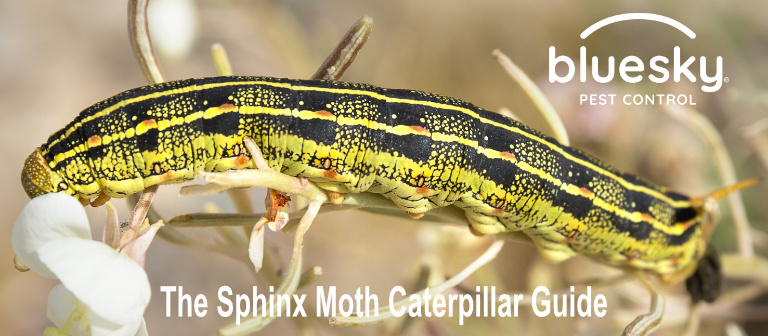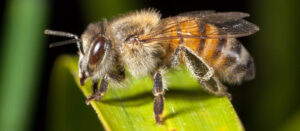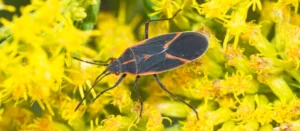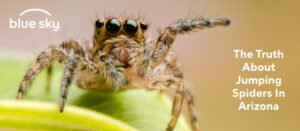$50 OFF New Residential Customers. Learn more
The Sphinx Moth Caterpillar Guide: Are They Dangerous?

One look at a sphinx moth caterpillar and it’s easy to picture a terrorizing menace in your garden, devouring every cherished plant in its path. Though, the real story behind these boldly adorned larvae is a little different. While there is no doubt their hearty appetite can create agriculture issues, these caterpillars aren’t the troublemakers they appear to be. In reality, they play a vital role in maintaining the delicate balance of Arizona’s ecosystems. While we don’t recommend or do pest control to get rid of sphinx moth caterpillars, we do pest control for the entire Phoenix area including Mesa, Chandler, Peoria, and even Anthem.
Sphinx Moth Caterpillar Overview
Sphinx moth caterpillars are a diverse group belonging to the Sphingidae family. These striking larvae are characterized by their vibrant colors, distinctive patterns, and formidable size. Typically, they range from 2 to 4 inches in length, with a robust body adorned with diagonal stripes and a distinctive horn-like projection on the hind end of most species. Their horned back side lends to their common name, the hornworm. This horn isn’t as menacing as it may appear; it’s merely a harmless appendage.
As for their habitat, sphinx moth caterpillars inhabit various regions across the United States, including Arizona. With their ability to adapt, they thrive in a wide range of ecosystems. You can find them in desert environments, grasslands, and even urban gardens. Being well adapted to hot and arid conditions makes Arizona’s Sonoran Desert a particularly suitable habitat.
Pest, Pollinator, or Snack
In terms of diet, these caterpillars primarily feed on plants from the Solanaceae family, which include well-known species like tomatoes, peppers, and eggplants, but also include crops like tobacco and cotton. Even with their voracious appetite for plants they are generally considered minor pests and do not warrant management. In addition, it’s important to recognize their role in local ecosystems. As moths, they are valuable pollinators to Arizona plant life. As caterpillars, they are an integral part of the food chain, serving as a food source for various predators, including birds and insects.
Should I Be Worried About Sphinx Moth Caterpillars?
Sphinx moth caterpillars are not poisonous, venomous, or dangerous to humans in any way. While their appearance may be intimidating, these caterpillars are harmless and lack any venomous or toxic defense mechanisms. Their primary defense strategy involves camouflage, blending into their surroundings to avoid detection by predators. Put simply, they pose no threat to humans and can be safely observed in their natural habitats without any risk of harm.
How Do I Protect My Garden From Sphinx Moth Caterpillars?
The best way to protect your garden is pretty straightforward. Simply monitor plants for damage and droppings. Should either be found, just follow the droppings trail and you’ll find the caterpillar. Once the caterpillar is located simply remove it by hand.
Different Types
Sphinx Moth caterpillars encompass a diverse group of species, each with their unique characteristics and habits. Here are a few notable examples:
- Tobacco Hornworm (Manduca sexta): These caterpillars are commonly found in North America and are known for their bright green color, diagonal white stripes, and the prominent red “horn” at the rear. They are often found feeding on tobacco and tomato plants.
- Tomato Hornworm (Manduca quinquemaculata): Similar in appearance to the tobacco hornworm, tomato hornworms are recognizable by their green bodies, V-shaped markings on their sides, and a black horn-like projection. They, as the name suggests, primarily feed on tomato plants.
- Waved Sphinx Moth (Ceratomia undulosa): The waved sphinx moth caterpillar is recognized by its lime green color with longitudinal stripes of white and green running along its body. They have a distinct horn-like projection at the rear, though it is often less pronounced compared to other sphinx moth caterpillars. These caterpillars can be found feeding on a variety of plants, including members of the grape family (Vitaceae) and Virginia creeper, making them adaptable residents in different North American regions.
- White-lined Sphinx (Hyles lineata): White-lined sphinx caterpillars are found in various habitats across North and South America. They are known for their unique coloration, featuring bold stripes of black, white, and various shades of green or brown. These caterpillars are adaptable and feed on a wide range of host plants. This species can be very common in Arizona.
- Achemon Sphinx (Eumorpha achemon): Achemon sphinx caterpillars are large and robust, with distinctive pale green bodies adorned with subtle diagonal lines and a horn-like tail. They often feed on grapevines and Virginia creeper.
- Pandorus Sphinx (Eumorpha pandorus): These caterpillars are characterized by their lime green coloration, bold black markings, and a pink-tipped horn at the rear. They are commonly found on various woody vines, such as grapevines and Virginia creeper.
The Sphinx Moth Caterpillar Guide Conclusion
Sphinx moth caterpillars may sport an intimidating appearance, but they are far from dangerous. These remarkable insects play an essential role in their ecosystem, contributing to biodiversity, pollination of Arizona plant life, and serving as a valuable food source for other wildlife. While they might occasionally graze on garden plants, their impact is usually minimal and should not be a cause for concern.
Instead of viewing them as pests, let’s appreciate the intricate beauty of sphinx moth caterpillars as a part of Arizona’s natural tapestry. However, if you do find yourself facing other pest-related challenges in the Arizona climate, remember that our team at Blue Sky Pest Control are here to assist you. With our expertise and customized pest control plans, we can ensure a pest-free environment that allows you to coexist harmoniously with the diverse flora and fauna of the Grand Canyon State. We do every kind of pest control from scorpion control to mosquito control and termite control. Click the button below to get your free quote on pest control in the Phoenix area.
Related Posts

Killer Bees in Arizona? Understanding Africanized Bees and How to Coexist Safely
You’ve likely heard the term “killer bees” used to describe Africanized bees in Arizona, but did you know this nickname…

Red & Black Intruders: Meet Arizona’s Boxelder Bugs
Boxelder Bugs in Arizona If you’ve ever stepped outside and spotted a cluster of black-and-red bugs crawling on your porch…

Jumping Spiders in Arizona: Harmless or Hazardous?
Jumping spiders in Arizona might be small, but they can certainly give you a big surprise when they suddenly appear…